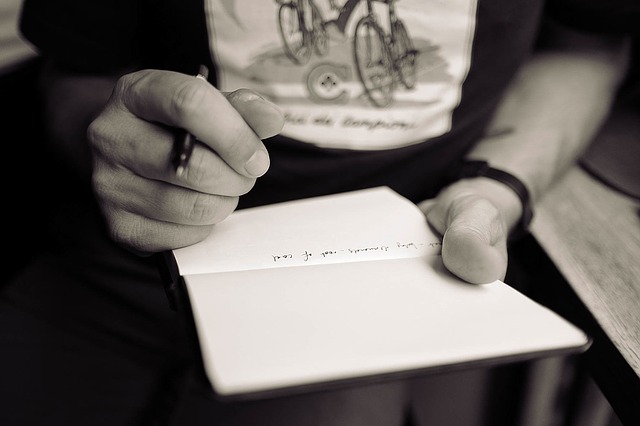Tension! What It Is & How to Develop It In Your Novel

Tension. It can spellbind your readers and leave them breathless, on the edge of their seats and biting their nails in anticipation for what will happen next. And, without it, your story will feel as lifeless and limp as a pricked balloon.
Tension is a required element in every story.
Readers want to feel excited when reading your story. They want to emotionally invest in your story, the characters and the scenes. The most effective way to elicit this response in your reader is through tension.
Find out if your novel has enough tension with this quick checklist. Subscribe to receive this extra resource.
What is Tension Exactly?

Tension is an abstract concept that can be explained in one word: anticipation.
An easy example for understanding tension is flirtation. When two people flirt, especially if there’s sexual chemistry involved, there’s an element of anticipation or a question that begs, where is this leading? Flirtation gives a coy hint to what’s possible.
To that end, tension can tighten or loosen as the story progresses. It’s almost impossible to keep the same amount of tension throughout a story, and why would you want to?
Ideally, you’ll want to start off with some tension but then tighten the tension as you get closer to the climax, or crisis point. Afterwards, you’ll naturally ease the tension because anticipation is no longer at play.
Four* Levels of Tension
To strike the right chord, you’ll need to have multiple levels of tension within your story. Let’s take a look at the major levels of tension at play in any novel:
Tension Within the Protagonist
As you introduce the protagonist into your story, there should be both internal conflict and conflict with some external force (whether that’s an antagonist, a series of unfortunate problems, etc.).
Tension Between the Characters
Show what each of the characters anticipate in every scene. What’s left unsaid between the characters?
Tension at Every Scene
Answer the questions, what is at stake for the characters in this scene? What could go wrong? What could go right?
Create a sense of anticipation with every scene. No only should every scene move the story forward, it should also increase the tension within the protagonist in some way.
Tension Within the Overall Story
There should be an element of anticipation in the overall story also. This will most likely be resolved after the climax. However, other layers of tension, such as that between or within characters, can stretch the entire scope of the story and be resolved towards the end.
*Optional Layer: Tension With the Narrator
This one won’t apply to every story, but for those of you using an unreliable narrator, you can develop a sense of tension and conflict between the narrator and the reader. Can I trust this narrator? Why don’t things add up? Who can I trust in this story?
With the unreliable narrator, the reader becomes part of the story.
It takes a special type of cunning to write as an unreliable narrator who must fool the reader (initially) while leaving a trail of breadcrumbs that are apparent in hindsight.
The Technical Side of Tension

There are certain devices you can use to create a sense of tension through your writing. Let’s explore those below:
Write shorter sentences.
Consider the length of your sentences when writing a tense scene. To help with the pace, and increase the level of tension, you should opt for short, punchy sentences. Avoid commas and sentences that flow and employ the use of staccato.
Use shorter words.
Shorter words can help you move the pace, too. Shorter words are quicker to consume and help keep the reader locked into the moment.
Reveal different tidbits of the story at a time to make the reader wonder.
Don’t show your hand too soon. Build up the tension slowly.
Color code your manuscript.
One of the easiest ways to determine if you’ve packed enough tension is to color code a chapter, or even just a scene, from your novel. Margie Lawson teaches color coding in her EDITS lecture.
The basic idea is that you can choose different colors for dialogue, internal thoughts, exposition, setting, action, and tension. Aim to have a relatively equal balance to all of the elements at play. If you see predominantly one color, it’s time to rework your writing. This can have a profound impact on both pacing and tension.
Understanding Conflict Vs. Tension
You already know what tension is, so let’s define conflict.
Conflict is when two opposing forces are pitted against each other. This can be character against character, character against idea or idea against idea.
Conflict and tension work hand in hand because conflict ideally leads to tension. Notice, I said, "ideally" and not "always" because conflict doesn’t inevitably create tension.
In order for conflict to lead to tension, there needs to be an emotional connection with the character(s). The audience needs to care about what happens or else you can have a lot of dead bodies, zombies, and broken hearts (conflict) but never create emotional investment and anticipation (tension).
Give Your Reader More Information Than You Give the Protagonist
If the reader knows what to expect but the protagonist doesn’t, it can create a great amount of tension within the scene.
Let’s say that the reader knows, through the help of an omniscient narrator, what’s coming next. They know what’s waiting for the character down the dark, mysterious path, and they are left anticipating what’s going to happen when the two collide.
This can make your reader feel things (yes!) for your character. Don’t go down that path, character! (But, do go down that path, writer.)
The Question of Flashbacks
I get it. Flashbacks are sometimes crucial to storytelling. You probably don’t want to start all the way in the past. You may want to start where the action is and then use a flashback to reveal some important truth the readers need to know.
However, the problem with flashbacks is that they often disrupt the forward tension of your story.
Although it’s possible (and pretty much required) to have tension in flashbacks, too many writers fail to infuse the flashback with enough tension to effect the current state of the characters.
You have to stop the forward momentum and take the reader back to another place and time. And you’ll need to start over from scratch with tension within that flashback.
But in general, the tension within a flashback is not as effective because there are no stakes. Whatever happened in the flashback occurred in the past and, although the events may influence the character(s) or give the reader a deeper understanding, it rarely adds to the current tension you’ve built up in your story so far.
The most honorable use of a flashback is to add context to what’s happening at present. That said, you should use this device sparingly, especially when your tension has reached a fever pitch because you will completely destroy the momentum.
The Soundtrack of Tension

One of the most effective ways to convey tension (at least in movies) is through music. A filmmaker can set the tone by choosing the right tone. But obviously, in your novel, you don’t have the luxury of playing a soundtrack to the reader.
But, I still think music is a great way to describe tension.
The tension within your novel should play like a classical piece played on a violin. There should be alternating moments of soft, sharp, loud, quiet, harmonious, discordant and stirring. But there should always be an active string.
Parting Thoughts
Tension is all about balance. Remember to allow your tension to ebb and flow. Not every moment of your novel should be tightly wound. It’s the symphonic play between relaxed and taunt on every layer that make your story “turn the page” gripping.
What’s your favorite example of tension in a novel? Let us know in the comments below!
Find out if your novel has enough tension with this quick checklist. Subscribe to receive this extra resource.




